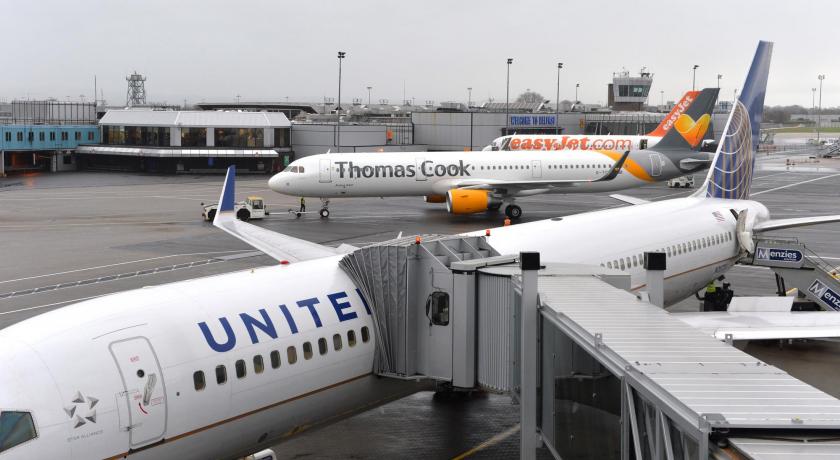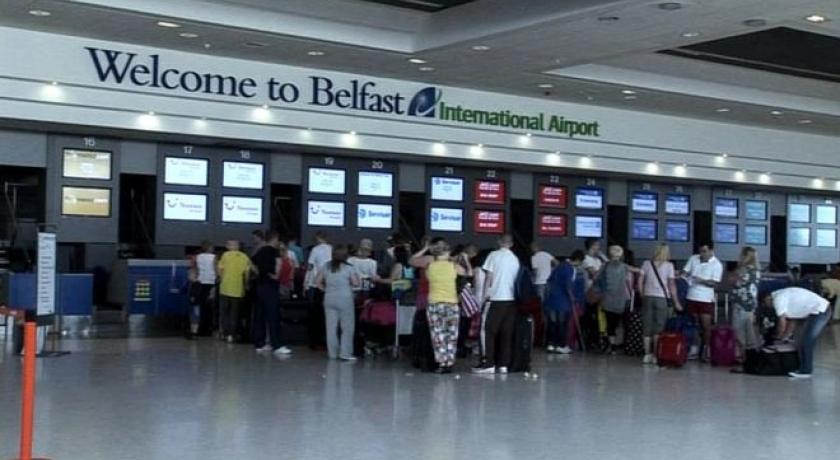Description
Belfast International Airport (IATA: BFS, ICAO: EGAA) is an airport 11.5 NM (21.3 km; 13.2 mi) northwest of Belfast in Northern Ireland. Formerly known as Aldergrove Airport, after the nearby village of Aldergrove, Belfast International is Northern Ireland's busiest airport and the second busiest airport on the island of Ireland, second only to Dublin Airport. In 2016, over 5.1 million passengers travelled through the airport, marking a 17% increase compared with 2015.
Belfast International has a CAA Public Use Aerodrome Licence that allows flights for the public transport of passengers or for flying instruction. The airfield was previously shared with the Royal Air Force base RAF Aldergrove which closed in 2008. The base is now known as Joint Helicopter Command Flying Station, Aldergrove and both runways are now owned by the airport. The airport is owned by ADC & HAS, the same company which owns Stockholm Skavsta, Orlando Sanford International Airport, Daniel Oduber Quirós International Airport, Mariscal Sucre International Airport and Juan Santamaría International Airport.
History
1917-1945
The airport lies within the parish of Killead, between the small villages of Killead (to the east) and Aldergrove (to the west). The site for the airport was established in 1917 when it was selected to be a Royal Flying Corps training establishment during the First World War. The airport remained open at the end of the war for RAF activity.
Civil traffic began in 1922 when flights were conducted flying newspapers from Chester and a regular civil air service started in 1933. The flight was to Glasgow and was operated by Midland and Scottish Air Ferries. This was subsequently augmented by flights to the Isle of Man, Liverpool and Croydon, then London’s airport.
During the Second World War, Aldergrove remained an RAF station particularly for the Coastal Command. So that the airport could accommodate larger, long-range aircraft, a major works programme was undertaken to replace the four existing runways with two new long paved runways, thereby forming the basis of the layout that still exists at the airport today.
1946-1970
One of the outcomes of the wartime airfield construction programme was the building of Nutts Corner Airport, just 3 mi (4.8 km) from Aldergrove. On 1 December 1946, the new site replaced Belfast Harbour Airport (now George Best Belfast City Airport) as Northern Ireland’s civil airport, as the site at Sydenham was considered unsuitable.
By the 1950s civil air traffic had outstripped the facilities at Nutts Corner and, in addition, aircraft were being regularly diverted to Aldergrove because of adverse weather conditions. In July 1959 the decision was made to move civil flights to Aldergrove to take advantage of the large airfield and this took place in October 1963.
A new terminal and apron were built with the necessary passenger facilities and the complex was opened by Queen Elizabeth, The Queen Mother on 28 October 1963. In 1966 the first regular jet service to London–Gatwick started and in 1968 Aer Lingus and BOAC introduced scheduled services to New York City via Shannon and Glasgow-Prestwick respectively.
1971-1999
In 1971 Northern Ireland Airports Limited was formed to operate and develop the airport and its facilities. A major programme of airfield upgrades was undertaken resulting in improvements to runways, taxiways and the parking apron.
A new International Pier was built together with lounge facilities and car parks, while an additional apron was provided to separate the smaller general aviation aircraft from large commercial jets. In the meantime, British Airways launched the first Belfast to Heathrow shuttle service and the first Boeing 747 operated from the airport on a charter service to Toronto via Shannon. The first scheduled service to a European city was started by NLM Cityhopper (now KLM Cityhopper) flying to Amsterdam.
In 1983 the airport, renamed Belfast International, was regularly accommodating the largest civil aircraft in service and with the installation of new technology was capable of all weather operations. In 1985 passenger numbers reached 1.5 million and BMI went into competition with British Airways on the Heathrow service. Further developments to the terminal occurred throughout the late 1980s and early 1990s. A new Executive Aviation Terminal was opened in 1987 and the new cargo centre opened in 1991.
The airport was privatised in 1994. TBI became the new owners of the airport on 13 August 1996, by which time annual passenger numbers had reached 2.5 million.
In 1998 Easyjet started operations from the airport with flights to London Luton. Since then the airline has established a large base at Belfast International and a further eleven domestic routes and fifteen direct European scheduled routes have been added to the network, making the airline the largest user of the airport.
Development since the 2000s
In 2005 Continental Airlines launched the first ever nonstop scheduled service to Newark, which continued to operate under the United Airlines brand until its termination in January 2017.
In July 2013, it was confirmed that abertis would sell Belfast International Airport, Stockholm Skavsta Airport & Orlando Sanford International Airport to ACD and HAS based in the United States.
In February 2015 the airport re-opened the viewing gallery that had been closed for 10 years which provides a view of the apron and the runways that serve the airport. It also includes live ATC, arrival and departure boards, and a live flightradar.
In January 2016 Ryanair announced that it would launch a new four times daily service to London Gatwick in direct competition with EasyJet which has operated the route for over 10 years. They also will establish 6 further routes in October 2016 in an investment worth $300 million and will create 750 jobs. Later on in the year Ryanair announced several more routes, including routes to Berlin and Milan. Ryanair also said they would carry 1.1 million passengers a year out of the airport.
In November 2016, United Airlines announced to terminate its service from Newark to Belfast by January 2017 cancelling the airport's only year-round long-haul route. On 24 February 2017, Norwegian Air Shuttle announced two new long-haul routes from Belfast International Airport. Services will operate five times a week, from July, between Belfast International and Stewart International Airport, about 70 miles from New York, and TF Green Airport, 60 miles from Boston.
Airlines and destinations
Passenger
The following airlines operate regular scheduled and charter flights to and from Belfast International:
Cargo
Belfast International Airport has a wide range of cargo operators at the airport, they are currently:
Traffic and statistics
Traffic figures
In 2007, the airport hit a record of 5.3 million passengers which is the highest in the airport's history. The figure remained static in 2008 but the figure declined sharply in 2009 to 4.5 million and again in 2010 to 4 million. Figures for 2011 indicated a small rise to 4.1 million, while a larger increase then occurred to 4.5 million in 2012, returning the total to 2009 levels. 2013 figures indicated a decrease to 4 million, which was roughly a return to the 2010 figures and the total remained static in 2014, but increased to nearly 4.4 million in 2015 and 5.1 million in 2016. The airport is the busiest in Northern Ireland and the second busiest airport on the island of Ireland, after Dublin Airport. Belfast International was the 10th busiest airport in the UK by passenger traffic in 2016.
Source: https://en.wikipedia.org/wiki/Belfast_International_Airport
Address
Belfast
Ireland
Lat: 54.662517548 - Lng: -6.216245174





